Knotless braids typically last for 6-8 weeks with proper care. Knotless braids are a popular protective hairstyle that offers a natural look and is gentle on the scalp.
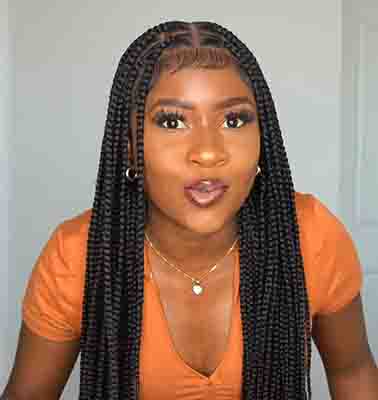
These braids are created without the use of bulky knots or extensions, making them lightweight and comfortable. The longevity of knotless braids largely depends on individual hair growth and maintenance routines.
On average, they can last anywhere from 6 to 8 weeks before requiring a touch-up or removal.
Proper care, such as regular cleansing, conditioning, and moisturizing, can help to extend the lifespan of knotless braids. It’s essential to follow a healthy hair care routine to ensure the longevity and health of your knotless braids.
Knotless Braids: A Beautiful and Gentle Protective Style
Knotless braids have become a beloved choice for many individuals seeking a protective and stylish hairstyle. Here are some key advantages of knotless braids:
1. Seamless and Natural Look
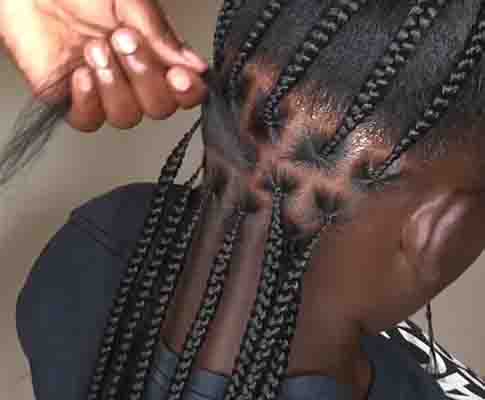
Knotless braids provide a seamless and natural appearance, as there are no knots at the base of each braid. This eliminates the bulky look often associated with traditional braids.
2. Reduced Tension on the Scalp
The braiding process of knotless braids involves gradually adding hair extensions without creating knots. This results in less tension at the roots, reducing the risk of scalp discomfort and hair breakage.
3. Lightweight and Comfortable
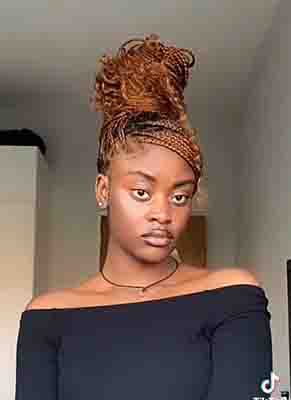
Knotless braids are known for their lightweight and comfortable feel. The absence of knots means that the braids do not pull or weigh down the hair, providing a more pleasant overall experience.
4. Longer Lasting
With proper care and maintenance, knotless braids can last for an extended period, typically up to eight weeks. This longevity saves time and effort in frequent re-installations.
5. Easy Removal
Removing knotless braids is a simpler and gentler process compared to traditional knotted braids. The absence of knots means less potential for hair breakage during the take-down process.
Factors That Determine Longevity
Absolutely, the longevity of knotless braids can vary depending on several factors:
1. Hair Type and Texture
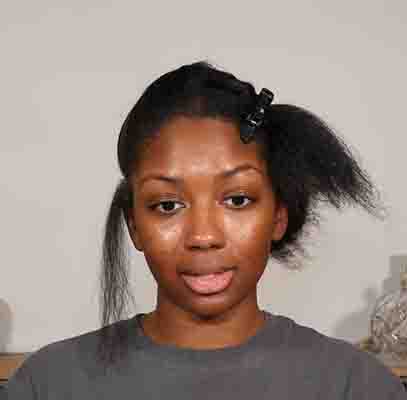
Different hair types and textures may have varying results with knotless braids. Fine or silky hair may require more maintenance and may not hold the style as long as thicker or coarser hair.
2. Stylist’s Skill and Technique
The skill and technique of the stylist play a significant role in the longevity of knotless braids. An experienced stylist who properly secures the braids will ensure they last longer.
3. Aftercare Routine
Proper aftercare is crucial for maintaining knotless braids. This includes regular moisturizing to prevent dryness and frizz, avoiding excessive manipulation or pulling, and protecting the braids while sleeping to minimize friction and damage.
4. Lifestyle and Activities
Your daily activities and lifestyle can impact how long knotless braids last. Activities that involve a lot of sweating or exposure to water may cause the braids to loosen more quickly.
5. Maintenance and Touch-Ups:
Regular maintenance, such as touch-ups for loose braids or frizz, can help extend the lifespan of knotless braids. It’s essential to address any issues promptly to prevent them from worsening.
6. Hair Products
The type of hair products you use can affect the braids. Using products that are too heavy or greasy may weigh down the braids and reduce their longevity.
How to Start Knotless Braids
I. Prepping Natural Hair
Starting knotless braids begins with proper preparation of your natural hair. Follow these steps:
a. Sectioning: Use a rat-tail comb or your fingertips to part your hair into neat sections, ensuring clean and even parts.
b. Securing Sections: Secure each section with hair ties or clips to keep them organized.
II. Applying Hair Products
Before beginning the braiding process, apply these hair products:
a. Leave-in Conditioner: Apply a leave-in conditioner to enhance moisture and prevent breakage during styling.
b. Oil: Use oil to further moisturize your hair.
c. Scalp Massage: Don’t forget to massage the products into your scalp to stimulate blood circulation, promoting overall hair health.
III. Preparing Braiding Hair
Prepare the braiding hair as follows:
a. Braid a Top Section: Start by braiding a small section at the top to keep the hair in place while you work.
b. Secure Ends: Secure the ends of the braiding hair with a hair tie to prevent tangles or knots.
IV. Measuring and Planning
Before you begin the braiding process, measure the length and determine the number of braid hair extensions needed. This ensures you have enough hair to complete the style and achieve your desired look.
V. Installing Knotless Braids
Use the feed-in technique to attach the braiding hair to your natural hair, following these steps:
a. Section by Section: Work section by section to ensure even and comfortable tension throughout the braids.
b. Roots to Ends: Start the braids closer to the roots and gradually make them thicker and fuller as you progress down the hair. This creates a more uniform appearance.
c. Reduce Strain: The feed-in technique reduces strain on your natural hair, minimizing potential breakage.
d. Consistency: Maintain a consistent and steady pace while braiding to ensure that each braid is secure and long-lasting.
VI. Practice and Patience
With practice and patience, you can master the art of starting knotless braids and enjoy a versatile and stylish hairstyle.
By following these steps and techniques, you’ll create beautiful knotless braids while promoting the health and strength of your natural hair.
Understanding Knotless Braid Tightness
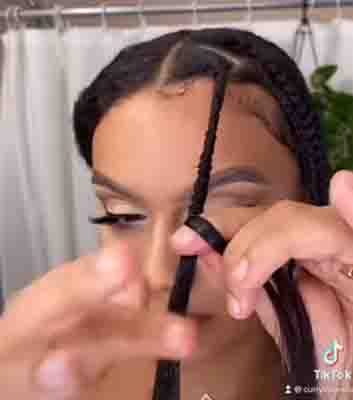
Knotless braid tightness should be carefully considered to avoid discomfort or damage.
When getting knotless braids, it is essential to ensure that they are not too tight.
Tight braids can lead to scalp tension, headaches, and even hair loss.
On the other hand, loose braids may not last as long or offer the desired aesthetic appeal.
There are several factors that affect knotless braid tightness, including hair texture, braid size, and braid pattern, as well as tension applied during installation.
These factors play a crucial role in determining the longevity and appearance of knotless braids.
Hair texture and thickness can impact how tightly the braids can be secured without causing discomfort or damage.
Additionally, the size and pattern of the braids can influence how well they grip the natural hair, affecting their tightness.
Finally, the tension applied during installation plays a pivotal role in ensuring the braids are secure but not overly tight.
Proper technique and skill are vital to achieving the desired tightness while maintaining the health of the hair.
Taking these factors into consideration will result in beautifully styled knotless braids that are comfortable to wear and last longer.
A knotless braid has several aspects to consider, including its tightness.
First, it helps avoid scalp tension and potential damage. By ensuring the braid is not too tight, you reduce the risk of discomfort or even hair breakage.
Secondly, proper braid tightness can significantly enhance the longevity of your hairstyle.
The optimal knotless braid tightness depends on a variety of factors.
One key aspect is selecting the right hair products, including those that promote smoothness and hold.
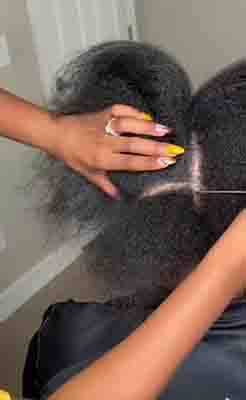
Another crucial element is employing proper sectioning and parting techniques to ensure even tension throughout the braids.
To adjust the tightness of knotless braids, you have a few options.
If your braids are too tight, gently loosen them by pulling them apart slightly. Start at the roots and work your way down, being careful not to damage the braids.
On the other hand, if your braids are too loose, you can tighten them by re-braiding small sections and securing them with rubber bands or hairpins.
Remember to distribute the tension evenly to avoid creating knots or lumps. If you’re unsure or uncomfortable making these adjustments yourself, it’s always a good idea to seek professional assistance.
A hairstylist or braiding expert can help you achieve the perfect balance of tightness and comfort for your knotless braids.
How To Make Knotless Braids Last Longer
Proper preparation, care, and maintenance are essential for extending the lifespan of knotless braids. Here’s a summary of your key points:
1. Preparing Your Hair
Properly preparing your natural hair before the braiding process, including washing, conditioning, and detangling, sets the foundation for long-lasting knotless braids.
2. Using the Right Products
Choosing the right hair products, such as lightweight oils, leave-in conditioners, and moisturizers, can help keep your braids hydrated and looking fresh.
3. Protecting Your Braids
Taking precautions while sleeping, exercising, or engaging in activities that may stress the braids, such as swimming, helps protect and preserve the style.
4. Regular Touch-Up Appointments
Scheduling regular touch-up appointments with your stylist ensures that any loose or frizzy braids are fixed promptly, maintaining the overall appearance of your knotless braids.
Signs Of Damage And When To Remove Knotless Braids
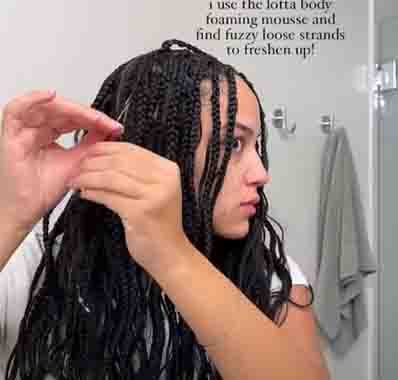
- Tension: If you notice your hairline is being pulled too tightly.
- Breakage: When natural hair gets tangled within the braids, it can lead to breakage.
- Thinning: Thinning hair may suggest that it’s time to take the braids out.
Recommended Duration for Knotless Braids:
Generally, it’s advisable to keep knotless braids for 4-8 weeks to minimize potential damage.
Proper Removal
When removing the braids, take your time, gently unravel them, and use conditioner to help loosen any stubborn knots.
What happens if you leave knotless braids in too long
1. Hair Weakening
When knotless braids are kept in for an extended duration, they can lead to hair weakening. This weakening is primarily due to the continuous stress applied to your hair strands.
2. Hair Breakage
As a consequence of weakened hair, breakage becomes a common concern. The tension and weight of the braids can cause the hair to become more fragile and prone to breakage.
3. Scalp Damage
Aside from harming your hair, leaving knotless braids in for too long can also result in scalp damage. The tightness of the braids can lead to various issues, including irritation, inflammation, and in severe cases, hair loss.
V. Individual Variations
It’s essential to acknowledge that the ideal duration for leaving knotless braids in varies from person to person. Different hair types and textures have different needs.
FAQ
Medium-sized knotless braids tend to last longer than smaller or larger ones because they balance durability with a manageable size.
Professional braids can last several weeks to a couple of months, depending on factors like your hair type, care, and the braid style.
Braids that are not too tight or heavy and are properly installed and maintained should not break your hair.
Braids can protect your hair, reducing breakage, which may give the appearance of longer hair over time.
Smaller braids generally take longer to install than larger ones due to their size and complexity.
Braids may not last long if they are installed too tightly, if there’s excessive tension on the hair, or if they are not properly maintained.
When done correctly, knotless braids should not excessively pull out your hair, as they are designed to minimize tension at the roots.
Hair growth isn’t significantly faster when braided, but braids can protect your hair, reducing breakage and promoting healthier-looking hair.
To remove knotless braids, carefully cut the extension hair at the base, then unravel the braids starting from the ends.
To make braids last longer, avoid excessive manipulation, keep the scalp clean, and moisturize your hair regularly.
It’s generally okay to get knotless braids wet, but it’s essential to dry them thoroughly afterward to prevent odor and potential damage.
To prevent frizz in knotless braids, apply a lightweight hair oil or serum to the braids and use a satin or silk scarf at night to reduce friction.
A sulfate-free, moisturizing shampoo is a good choice for washing knotless braids, as it cleanses without stripping moisture.
Knotless braids should stay in place when installed correctly and with proper care, but individual experiences may vary.
Knotless braids can look fresh for several weeks to a couple of months, depending on factors like care and hair type.
Conclusion
The longevity of knotless braids is impressive, making them a popular choice for many individuals seeking a low-maintenance and long-lasting hairstyle. With proper care and maintenance, knotless braids can last anywhere from four to eight weeks, ensuring you can enjoy your new look for an extended period.
Additionally, the lighter tension and seamless technique used in creating knotless braids result in less damage and discomfort compared to traditional braiding methods. This not only enhances the overall health of your hair but also allows for a more comfortable and enjoyable experience.
Whether you’re looking to try out a new style or simply want a long-lasting protective hairstyle, knotless braids provide a fantastic option. Consider discussing your specific needs with a professional stylist to ensure the best results and longest-lasting braids.

